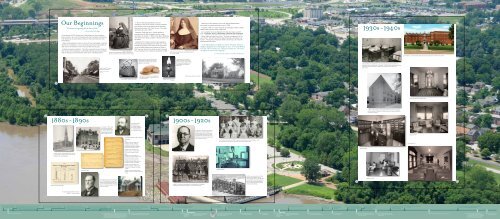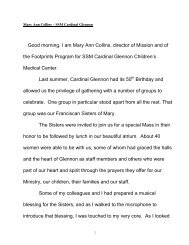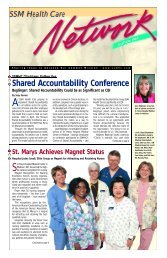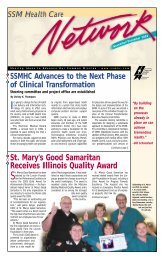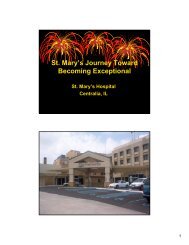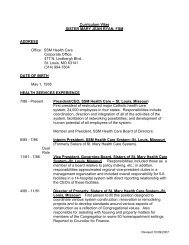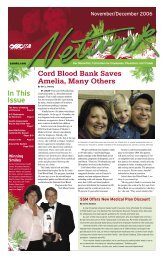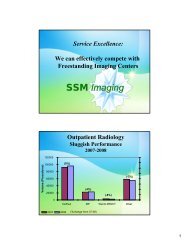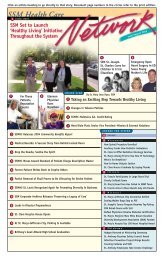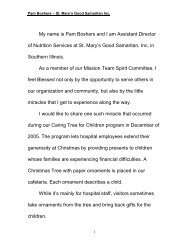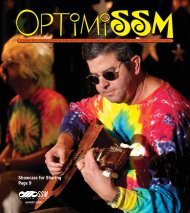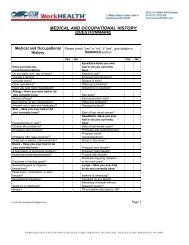new heritage wall - SSM Health Care
new heritage wall - SSM Health Care
new heritage wall - SSM Health Care
Create successful ePaper yourself
Turn your PDF publications into a flip-book with our unique Google optimized e-Paper software.
Our Beginnings<br />
“Continue courageously for the love of God.”<br />
• Mother Mary Odilia Berger<br />
On November 16, 1872, Mother Mary Odilia Berger and five companion<br />
sisters arrived in St. Louis from Bavaria with only five dollars among them.<br />
Their dream was to serve God by caring for those who were poor, sick<br />
and suffering.<br />
Mother Odilia walked from door to door with her small basket, collecting<br />
food for her companions. In turn, the sisters would carry their baskets to<br />
take food to the families for whom they provided nursing care.<br />
Smallpox became an epidemic. The sisters rang a bell to warn others of<br />
their contact with the disease. So intimately did they become associated<br />
with this disease, that they became known as the “Smallpox Sisters.”<br />
Copyright Franciscan Sisters of Mary. All rights reserved.<br />
Reprinted with permission.<br />
Mother Mary Odilia Berger, founder of the Sisters of<br />
St. Mary, now known as the Franciscan Sisters of Mary<br />
In 1873, Sr. Mary Elizabeth Becker and two<br />
companions came to St. Charles to care for smallpox<br />
and cholera victims at the request of the Reverend<br />
Edward Koch, pastor of St. Peter Church. The sisters<br />
returned to St. Louis in 1876.<br />
Epidemics came and went. In 1879, diphtheria<br />
presented, and Sr. Mary Elizabeth and four sisters<br />
returned to St. Charles. In 1884, scarlet fever, diphtheria<br />
and cholera were raging, so again, a request came from<br />
the pastor.<br />
Residents of St. Charles now k<strong>new</strong> they needed a<br />
more permanent arrangement for health care. Franz<br />
Schulte was grateful to the sisters for having nursed<br />
his son through diphtheria and offered his home at<br />
305 Chauncey Street to the sisters to start a hospital.<br />
They arrived back in St. Charles on November 4, 1885.<br />
Courtesy of <strong>SSM</strong> Corporate Archives.<br />
Sister Mary Elizabeth Becker, first administrator of<br />
St. Joseph Hospital.<br />
Tuberculosis cases steadily rose, and Sr. Mary Elizabeth Becker<br />
contracted the disease and died on April 11, 1890.<br />
In August of 1891, St. Joseph Hospital was dedicated. <strong>SSM</strong> St. Joseph<br />
<strong>Health</strong> Center remains on the original site.<br />
Our wonderful history is reflected in the five core values we hold<br />
dear — excellence, respect, stewardship, community and compassion.<br />
Mother Odilia reminded the sisters: “Continue courageously for the<br />
love of God.” We continue this <strong>heritage</strong> of healing as revealed in our<br />
mission: “Through our exceptional health care services, we reveal the<br />
healing presence of God.”<br />
“I am inspired daily, not only by our mission and values, but by our<br />
employees and physicians and the people we serve. Sr. Francine Burkert<br />
once said, ‘We can’t always cure. But we can always care.’ Her words<br />
can inspire our actions every single day.”<br />
• Sr. Mary Jean Ryan, FSM, President/CEO, <strong>SSM</strong> <strong>Health</strong> <strong>Care</strong><br />
1930s -1940s<br />
Postcard of St. Joseph Hospital, 1930s (facing First Capitol Drive, formerly Clay Street)<br />
Main Street, St. Charles,<br />
Missouri, late 1800s<br />
Basket carried by Founder Mother Mary<br />
Odilia Berger to distribute and receive<br />
supplies for her sisters as they cared for<br />
patients in their homes.<br />
Lamp given to the founding<br />
Sisters of St. Mary, now known<br />
as the Franciscan Sisters of Mary,<br />
by an observant neighbor who<br />
noticed they had no lights in<br />
their home.<br />
Nursery, 1930s. Post World War II saw a boost of business in the obstetrical<br />
department as the “baby boomer” era began. A 1945 addition boasted a third floor<br />
reserved for obstetric patients, complete with a delivery room, labor room<br />
and nursery.<br />
Missouri History Museum,<br />
St. Louis.<br />
Copyright Franciscan Sisters of Mary.<br />
All rights reserved. Reprinted with permission.<br />
The bread is symbolic to our organization.<br />
The sisters provided for others; the Lord<br />
provided for them.<br />
Copyright Franciscan Sisters of Mary.<br />
All rights reserved. Reprinted with<br />
permission.<br />
305 Chauncey Street, St. Charles<br />
Hospital Entrance and Lobby, 1947<br />
In 1945, a <strong>new</strong> wing was constructed on the north side of the hospital<br />
campus, adding 40 beds and including wards with oxygen available at<br />
the patient’s bedside.<br />
1880s -1890s 1900s -1920s<br />
St. Peter Church in the late 1800s. The church<br />
provided loans and donations to help with the<br />
building of St. Joseph Hospital.<br />
On August 12, 1891, a <strong>new</strong><br />
hospital was dedicated.<br />
St. Joseph Hospital was a<br />
two-story brick structure<br />
located across the street<br />
from St. Peter Church.<br />
Dr. Benjamin Geret,<br />
1887, performed<br />
St. Joseph Hospital’s<br />
first known operation<br />
— a cholecystectomy,<br />
or gallbladder removal.<br />
First page of logbook, 1887, in German.<br />
Translation:<br />
1887<br />
(Patient name removed) from<br />
St. Peters, German, Catholic,<br />
operation for pain from cancer<br />
(undisclosed location) treated by<br />
Dr. Geret, recovering 3 weeks<br />
(Patient name removed) from<br />
Detroit, German, nervous fever,<br />
Dr. Geret, recovering 3 weeks<br />
1888<br />
(Patient name removed) from<br />
St. Charles, German, Catholic, fever,<br />
Dr. Bruer, recovering 7 weeks<br />
(Patient name removed) from<br />
St. Peters, German, Catholic, fever,<br />
Dr. Blanek, recovering 4 weeks<br />
In 1903, Dr. Frank Tainter was the first<br />
surgeon at St. Joseph Hospital. The<br />
operating table was in the pharmacy;<br />
the instruments, gloves and brushes<br />
were boiled on the kitchen stove and<br />
sterile gowns and linens were brought<br />
from St. Mary’s Infirmary.<br />
The Thimble Club, formed in 1900, focused on volunteer service at the hospital. It was<br />
the forerunner of the Women’s Auxiliary, which was founded in 1935.<br />
Pharmacy, 1947<br />
Solarium, 1947<br />
The Chapel, 1947<br />
Patient bill, 1896<br />
(Patient name removed) from<br />
St. Peters, German, Catholic, arm<br />
removed Dr. Morgener, recovering<br />
4 weeks<br />
(Patient name removed) German,<br />
Catholic, senility, Dr. Mudd, recovering<br />
11 days<br />
Radiology, 1920s<br />
Nursing summary, 1891-1897<br />
The Stumberg house, which was built<br />
by Dr. Stumberg’s father in 1869, still<br />
stands on the hospital property and<br />
is on the National Register of Historic<br />
Places. Dr. Stumberg used part of the<br />
home as his office.<br />
In 1904, a two-story, 50-bed addition to the hospital was completed.<br />
The addition included an operating room and serving kitchen.<br />
Another <strong>new</strong> wing was built in 1924,<br />
adding 21 more beds as well as<br />
clinical facilities and the first elevator.<br />
Several patient rooms had lavatories<br />
and one had a complete bathroom.<br />
The wing was built off the east side<br />
of the original building.<br />
Laboratory, 1947<br />
Dr. Kurt Stumberg, 1891, first Chief of<br />
Staff at St. Joseph Hospital<br />
1847: The American Medical 1849: Elizabeth Blackwell was the first woman to receive a<br />
Association was founded. medical degree at an American college (Geneva<br />
Medical College), although her name was not<br />
mentioned in the commencement program.<br />
1854: Florence Nightingale and a staff of 1857: The National Deaf Mute College (later<br />
38 nurses were sent to the Crimean War. renamed Gallaudet University) was established<br />
in Washington, DC, becoming the first school<br />
for the advanced education of the deaf.<br />
1864: Rebecca Lee became the first black<br />
woman to receive a US medical degree,<br />
from the New England Female Medical<br />
College in Boston.<br />
1867: Joseph Lister developed antiseptic surgical methods, using carbolic acid to clean<br />
wounds and surgical instruments. In one hospital that adopted his methods, deaths<br />
from infection decreased from nearly 60 percent to just 4 percent.<br />
1879: Louis Pasteur demonstrated value of<br />
vaccine to protect sheep against anthrax.<br />
1882-3: Microorganisms are found to be responsible<br />
for tuberculosis, cholera and diphtheria.<br />
1890: Effective diphtheria<br />
antitoxin developed.<br />
1893: Johns Hopkins University Medical<br />
School, the first modern American<br />
1897: Aspirin was invented in Germany. 1906: Typhoid fever was on the rise. 1913: American<br />
Cancer Society<br />
1915: American Heart<br />
Association was<br />
medical school, opened in Baltimore.<br />
was founded.<br />
founded.<br />
1918-19: Influenza pandemic deaths<br />
worldwide are estimated between<br />
30 and 50 million; 675,000 in<br />
the United States.<br />
1921: Heart disease named the<br />
leading cause of death in<br />
the United States.<br />
1927: Cancer named one of the<br />
top three causes of death<br />
in the United States.<br />
1930: Researchers discover riboflavin, or<br />
vitamin B2.<br />
1941: First clinical trials of penicillin showed remarkable<br />
ability to cure life-threatening infections.<br />
1848: St. Peter Church was built.<br />
1870: The population of St. Charles was 6,000. There were<br />
18 dry goods stores, 10 grocery stores, four cigar stores,<br />
three tin stores, three gunsmiths, two harness makers,<br />
five wagon makers, seven blacksmiths, five flour mills,<br />
three billiard saloons, a stone jail and 10 churches.<br />
1873: The Sisters of St. Mary came to St. Charles<br />
during the height of the smallpox epidemic.<br />
1884: Scarlet fever<br />
and diphtheria<br />
epidemic in<br />
St. Charles.<br />
1885: First hospital in St. Charles County,<br />
St. Joseph Hospital, opened at<br />
305 Chauncey Street.<br />
1891: St. Joseph Hospital, a <strong>new</strong> 28-bed,<br />
red brick structure, opened across<br />
from St. Peter Church.<br />
1896: The first baby was born<br />
at St. Joseph Hospital.<br />
1900: Hospital installs<br />
first telephone.<br />
1903: Hospital gets<br />
first “real”<br />
operating table<br />
donated.<br />
1904: Dr. Kurt Stumberg purchases<br />
hospital’s first “blood testing”<br />
machine.<br />
1910: Hospital, for the first time,<br />
employs registered pharmacists.<br />
1915: Hospital acquires first<br />
X-ray equipment.<br />
1920: The hospital admits 3,778 patients<br />
this year – 1,802 charity, 972 part-pay<br />
and 1,004 full pay.<br />
1924: A <strong>new</strong> wing with 21 beds, clinical<br />
facilities and an elevator was added<br />
to the hospital.<br />
1935: St. Joseph Hospital Auxiliary was founded. 1945: New, four-story wing opened at a<br />
cost of $200,631 including equipment<br />
and furnishings. “Bell boxes” replaced<br />
with an electrical call light system<br />
throughout the St. Joseph Hospital.<br />
1947: The St. Charles<br />
Clinic was founded.
1970s<br />
1950s -1960s<br />
1980s<br />
The Physical Therapy Department at<br />
St. Joseph Hospital was established in 1961.<br />
Postcard of St. Joseph Hospital, 1950s<br />
Admissions, 1950s<br />
The second phase of the “C” wing expansion was the “D” wing, which was added to the north<br />
side. The <strong>new</strong> wing included housekeeping, central service, administration and five patient<br />
care floors.<br />
The hospital’s main entrance on Third Street, 1973. A two-level parking<br />
garage was added on the other side of Third Street that year.<br />
Aerial photo of hospital campus, 1974<br />
Construction on the “E” wing began in 1981 and<br />
was completed in 1983. The <strong>new</strong> area included<br />
emergency, surgery, lab and intensive care.<br />
Aerial view of the campus in the early 1980s. The hospital first was<br />
designated as a Level II Trauma Center in 1981, and has held the<br />
designation since.<br />
Radiology, 1960s<br />
In 1982, the hospital’s name<br />
officially changed to<br />
St. Joseph <strong>Health</strong> Center.<br />
Pictured is Bill Schoenhard,<br />
the hospital’s Executive<br />
Director from 1982-1987.<br />
St. Joseph’s <strong>new</strong>sletter<br />
chronicled the “B” wing<br />
expansion in 1977.<br />
The 1924 and 1945<br />
hospital structures<br />
were remodeled,<br />
expanded and named<br />
the “B” wing.<br />
In 1985, St. Joseph participated in a St. Charles parade with a float<br />
that celebrated its centennial year.<br />
The <strong>new</strong> Odilian Gift Shop, located off the lobby, boasted expanded space, merchandise<br />
and fundraising potential.<br />
The “A” wing along Second Street was completed in 1961.<br />
This six-story addition was entirely air-conditioned. The wing<br />
included 76 beds for medical and surgical patients, delivery and<br />
labor rooms, a modern surgical suite, recovery room, radiology,<br />
laboratory, laundry and power plant.<br />
Mass in the Chapel at St. Joseph Hospital.<br />
Cardinal Glennon Children’s Hospital’s “Glennon Adolescent and Pediatric<br />
Unit” opened at St. Joseph <strong>Health</strong> Center in 1982.<br />
In 1969, the “C” wing was dedicated, completing the first part of<br />
a two-phase expansion that started in 1966. The <strong>new</strong> wing was a<br />
five-story structure housing the emergency and radiology<br />
departments, pharmacy, intensive care unit, patient area, chapel<br />
and cafeteria. The third floor had an additional 18 patient beds,<br />
bringing the hospital’s total capacity to 205 beds.<br />
The hospital’s first cardiac catheterization laboratory and special procedures<br />
area opened in 1986. The lab offered multiple forms of invasive cardiac<br />
test procedures to determine the severity, location and degree of possible<br />
heart problems.<br />
Nurses inspect state-of-the-art cardiac monitoring equipment<br />
in a <strong>new</strong> intensive care unit, which opened in 1969.<br />
St. Joseph <strong>Health</strong> Center became the first hospital in the area<br />
to introduce birthing rooms—a <strong>new</strong> concept in obstetrics that<br />
offered a relaxed atmosphere and the convenience of a one-room<br />
procedure in birthing.<br />
St. Joseph Hospital Laundry, 1960s<br />
St. Joseph Hospital in 1961. The house in the photograph was owned by three<br />
siblings. All three attended St. Peter Church across the street, did not drive and<br />
had jobs on Main Street so they could walk to work.<br />
When first approached by the hospital, they didn’t want to sell, but later agreed<br />
to move if the hospital could find and purchase them a home nearby. A home was<br />
purchased for them in the 300 block of Madison Street.<br />
When the hospital later needed that home for the “C” wing expansion, another<br />
home was purchased for them at 330 Tompkins Street.<br />
St. Joseph <strong>Health</strong> Center’s first Medical Office Building opened in<br />
1988. Physician specialists moved their offices into the building,<br />
providing convenience for both physicians and patients.<br />
On December 15, 1986, St. Joseph<br />
Hospital West opened in Lake<br />
Saint Louis.<br />
1950: Canadian John Hopps<br />
invented world’s first<br />
cardiac pacemaker.<br />
1953: First successful open heart surgery<br />
using heart-lung machine performed at<br />
Jefferson Medical College, Philadelphia.<br />
1954: First successful kidney<br />
transplant was performed<br />
in Boston.<br />
1956: American Cancer<br />
Society links<br />
cigarette smoking<br />
to lung cancer.<br />
1957: Ultrasound was invented by the<br />
English physician Ian Donald.<br />
1960: National Lung Association<br />
launched an antismoking campaign<br />
with the message, “Kick the Habit.”<br />
1963: First liver transplant<br />
performed.<br />
1964: First vaccine for<br />
measles.<br />
1965: Congress passes legislation creating Medicare and Medicaid.<br />
Congress passes law requiring label on cigarette packages:<br />
“Warning: Cigarette Smoking may be Hazardous to your <strong>Health</strong>.”<br />
1967: World’s first human heart transplant performed by<br />
Christiaan Barnard in Cape Town, South Africa.<br />
First coronary bypass operation using person’s vein<br />
performed in Ohio.<br />
1970: Pediatric respirator greatly reduced<br />
infant mortality for babies with<br />
respiratory problems.<br />
1973: CAT scan invented by<br />
Godfrey Hounsfield<br />
and Allan Cormack.<br />
1974: Chicken pox vaccine established.<br />
Raymond Damadian, American physician, was granted a patent on<br />
his invention of the magnetic resonance imaging device.<br />
1977: First vaccine for<br />
pneumonia.<br />
1981: First vaccine<br />
for hepatitis B.<br />
1982: First heart and lung<br />
transplant performed.<br />
1983: HIV, the virus that causes AIDS,<br />
was identified.<br />
1987: First brain tissue<br />
transplant performed.<br />
1988: Patricia Bath became the first African-<br />
American woman doctor to receive a<br />
patent for a medical invention.<br />
1951: St. Louis population began migrating westward<br />
to St. Louis County and St. Charles County.<br />
1956: The hospital employed<br />
200 and payroll was<br />
$412,000; 21 Sisters<br />
contributed services.<br />
1957: Hospital opened pediatric unit.<br />
1959: Blanchette Memorial Bridge opened,<br />
carrying Interstate 70 traffic across the<br />
Missouri River between St. Louis County<br />
and St. Charles County.<br />
1961: Six-story,<br />
air-conditioned<br />
east wing opened.<br />
1962: Population of St. Charles<br />
was 21,289.<br />
1966: Ground breaking for the first<br />
phase (First Capitol addition) of<br />
a seven-year building program.<br />
1969: Original 1891 hospital building vacated<br />
after the “C” wing was completed.<br />
1972: First patient admitted to <strong>new</strong><br />
150-bed “D” wing.<br />
1974: Pastoral <strong>Care</strong> Department was established. 1976: Extensive modernization and<br />
1978: St. Joseph Hospital adds oncology and<br />
renovation began throughout<br />
orthopedic units.<br />
the hospital.<br />
Hospital’s “B” wing added 71 more beds.<br />
1980: St. Joseph Perinatal<br />
Clinic opened.<br />
1981: St. Joseph received<br />
state-designation as a<br />
Level II Trauma Center.<br />
1982: St. Joseph Hospital name changed<br />
to St. Joseph <strong>Health</strong> Center.<br />
1984: Heliport added outside<br />
Emergency Department entrance.<br />
1986: St. Joseph Hospital<br />
West opened.<br />
1987: St. Joseph performed its<br />
first open heart surgery.
1990s<br />
<strong>SSM</strong> <strong>Health</strong> <strong>Care</strong> purchased<br />
the St. Charles Clinic in 1994<br />
and renamed it <strong>SSM</strong> St. Charles<br />
Clinic Medical Group.<br />
<strong>SSM</strong> St. Joseph <strong>Health</strong> Center Presidents<br />
The Harmon Institute for Heart and Lung<br />
Rehabilitation opened in 1999.<br />
Sister Mary Isadore Boland, <strong>SSM</strong><br />
Hospital Administrator<br />
1894-1902<br />
(photo not available)<br />
The St. Joseph Breast Center opened in 1991.<br />
The Center brought all the mammography<br />
services together in one location. As a result,<br />
a mammography exam could be completed in<br />
one hour.<br />
St. Joseph <strong>Health</strong> Center became<br />
the first health care facility in the<br />
three-county area to offer magnetic<br />
resonance imaging (MRI) services.<br />
The second Medical Office Building opened in 1999, enabling<br />
more physicians to move their offices on campus.<br />
Sister Mary Elizabeth Becker, <strong>SSM</strong><br />
Hospital Administrator<br />
1885-1890<br />
Sister Mary Clara Harbers, <strong>SSM</strong><br />
Hospital Administrator<br />
1890-1894<br />
Sister Mary Dominica Sanders, <strong>SSM</strong><br />
Hospital Administrator<br />
1902-1908<br />
(photo not available)<br />
Sister Mary Petronilla Mueller, <strong>SSM</strong><br />
Hospital Administrator<br />
1908-1916<br />
Sister Mary Veronica Roesler, <strong>SSM</strong><br />
Hospital Administrator<br />
1916-1921<br />
Sister Mary Columba Heyden, <strong>SSM</strong><br />
Hospital Administrator<br />
1921-1922<br />
Sister Mary Alexia Koehne, <strong>SSM</strong><br />
Hospital Administrator<br />
1922-1928<br />
A <strong>new</strong> gallbladder procedure — laparoscopic cholecystectomy<br />
— began at the hospital in 1991. Four small incisions were made<br />
in the skin; a video scope was inserted in one of the incisions<br />
and miniature instruments were inserted in the other three.<br />
Aerial view of <strong>SSM</strong><br />
St. Joseph <strong>Health</strong><br />
Center campus, 1994<br />
The Outpatient Surgery Center<br />
opened in 1995. The <strong>new</strong> facility<br />
boasted separate admitting,<br />
surgery preparation, family<br />
waiting and recovery areas.<br />
The hospital’s first linear accelerator was installed in 1996 in<br />
the radiation oncology suite. Among other procedures, the<br />
accelerator could treat cancerous scalp tissues while sparing<br />
the underlying brain tissue.<br />
Sister Mary Bernadette Hogan, <strong>SSM</strong><br />
Hospital Administrator<br />
1928-1932<br />
Sister Mary Benedict Kuyven, <strong>SSM</strong><br />
Hospital Administrator<br />
1932-1938<br />
Sister Mary Adolphine Schoenig, <strong>SSM</strong><br />
Hospital Administrator<br />
1938-1941<br />
Sister Mary Marcelline Kollmeyer, <strong>SSM</strong><br />
Hospital Administrator<br />
1941-1944<br />
Sister Mary Josetta Witte, <strong>SSM</strong><br />
Hospital Administrator<br />
1944-1947<br />
Sister Mary Carmelita Renz, <strong>SSM</strong><br />
Hospital Administrator<br />
1947-1949<br />
Sister Mary Bernardine<br />
Hamnauer, <strong>SSM</strong><br />
Hospital Administrator<br />
1949-1955<br />
Sister Mary Athanasia Brune, <strong>SSM</strong><br />
Hospital Administrator<br />
1955-1958<br />
Sister Mary Sebastian Book, <strong>SSM</strong><br />
Hospital Administrator<br />
1958-1964<br />
Sister Mary Henrica Strassmann, <strong>SSM</strong><br />
Hospital Administrator<br />
1964-1967<br />
Sister Mary Francis Clare Brown, <strong>SSM</strong><br />
Executive Director<br />
1967-1971<br />
Robert J. Coleman<br />
Executive Director<br />
1971-1981<br />
Douglas A. Ries<br />
Interim Executive Director<br />
1981-1982<br />
William C. Schoenhard<br />
Executive Director<br />
1982-1987<br />
2000-2010<br />
<strong>SSM</strong> <strong>Health</strong> <strong>Care</strong> was<br />
the first health care<br />
organization to receive<br />
the prestigious Malcolm<br />
Baldrige National<br />
Quality Award in 2002.<br />
Marty Strussion<br />
President<br />
1987-1989<br />
Kevin F. Kast<br />
Executive Director<br />
1989-1994<br />
Kurt Weinmeister<br />
President<br />
1994-1998<br />
Kevin F. Kast<br />
President, CEO<br />
1998-2005<br />
Paul Convery, M.D.<br />
Interim President<br />
2005<br />
Sherlyn Hailstone<br />
President<br />
2005-2008<br />
Gaspare Calvaruso<br />
President<br />
2008<br />
<strong>SSM</strong> St. Joseph Medical Park, a 100,000 square-foot<br />
ambulatory care center and physician office building,<br />
opened in St. Peters in 2004.<br />
<strong>SSM</strong> St. Joseph <strong>Health</strong> Center’s lobby was<br />
remodeled in 2004.<br />
<strong>SSM</strong> <strong>Health</strong> <strong>Care</strong> purchased Crossroads Regional Hospital in<br />
Wentzville in 2005 and changed the name to <strong>SSM</strong> St. Joseph<br />
<strong>Health</strong> Center-Wentzville.<br />
St. Joseph <strong>Health</strong> Center received the Missouri Quality<br />
Award in 2005, the Premier Award for Heart Attack<br />
<strong>Care</strong> in 2007, the Premier Award for Quality in 2008<br />
and the American Heart Association/American Stroke<br />
Association Gold Performance Achievement Award<br />
for Stroke in 2009 and 2010.<br />
The cafeteria was renovated and Odilia’s<br />
opened in 2008.<br />
1957<br />
1969<br />
1973<br />
In 2009, <strong>SSM</strong> <strong>Health</strong> <strong>Care</strong><br />
received the Diversity<br />
Leader Award from the<br />
Human Resources<br />
Management Association<br />
of Greater St. Louis. The<br />
Diversity Council at <strong>SSM</strong><br />
St. Joseph <strong>Health</strong> Center<br />
holds programs throughout<br />
the year to celebrate our<br />
diverse workforce.<br />
The <strong>SSM</strong> St. Joseph Auxiliary received the<br />
Missouri Hospital Association’s Auxiliary of<br />
the Year Award in 2009.<br />
1982<br />
Early 1990s<br />
A <strong>new</strong> ICU opened in 2010.<br />
2009<br />
St. Joseph <strong>Health</strong> Center<br />
1995<br />
A <strong>new</strong>, state-of-the-art<br />
Cardiac Catheterization Lab<br />
opened in 2010.<br />
Phase 1 of the <strong>new</strong> Emergency Department<br />
was completed in 2010.<br />
1992: First vaccine for hepatitis A. 1993: Intravenous Catheter Shield invented by<br />
St. Louisans Betty Rozier and Lisa Vallino.<br />
1996: Dolly, a sheep, is the first mammal<br />
to be cloned from an adult cell.<br />
1998: First vaccine for lyme disease.<br />
2000: First draft of mapping of the United States<br />
Human Genome Project completed.<br />
2007: Scientists discovered how to use human skin cells to create embryonic stem cells.<br />
The first procedure using robotic-assisted technology was performed in the U.S.<br />
2009: The World <strong>Health</strong> Organization declared the H1N1 influenza<br />
(commonly known as “swine flu”) as a pandemic.<br />
1990: First brain surgery performed with<br />
a laser in St. Charles County takes<br />
place at St. Joseph <strong>Health</strong> Center.<br />
1991: The population of St. Charles County<br />
was 218,600 and growing rapidly.<br />
1993: The Great Flood of ’93 occurred<br />
along the Mississippi and Missouri<br />
Rivers in St. Louis and St. Charles,<br />
devastating residents.<br />
1994: <strong>SSM</strong> <strong>Health</strong> <strong>Care</strong> acquired the St. Charles<br />
Clinic, the largest multi-specialty medical<br />
group in St. Charles County.<br />
1995: St. Joseph <strong>Health</strong> Center opened the area’s first<br />
fully monitored Sleep Disorders Laboratory.<br />
1997: The St. Louis <strong>Health</strong> <strong>Care</strong> Network becomes<br />
<strong>SSM</strong> <strong>Health</strong> <strong>Care</strong> – St. Louis; the hospital’s official<br />
name becomes <strong>SSM</strong> St. Joseph <strong>Health</strong> Center.<br />
1999: <strong>SSM</strong> <strong>Health</strong> <strong>Care</strong> adopted a <strong>new</strong> mission<br />
statement for the entire system – “Through<br />
our exceptional health care services, we reveal<br />
the healing presence of God.”<br />
2001: St. Joseph <strong>Health</strong> Center was awarded<br />
first MissouriPRO Quality Award.<br />
2002: <strong>SSM</strong> <strong>Health</strong> <strong>Care</strong> was the first health care organization in the country<br />
to receive the prestigious Malcolm Baldrige National Quality Award.<br />
2004: St. Joseph Medical Park opened<br />
in St. Peters, offering full-service<br />
outpatient services.<br />
2005: The American Stroke Association recognized<br />
the hospital as a “Get With the Guidelines”<br />
stroke center.<br />
2006: <strong>SSM</strong> purchased <strong>SSM</strong> St. Joseph <strong>Health</strong> Center-Wentzville, an<br />
existing hospital that had served residents in western St. Charles,<br />
Lincoln, Montgomery, and Warren counties since 1987.<br />
2010: A <strong>new</strong> $4.6 million ICU opened at St. Joseph<br />
<strong>Health</strong> Center – including 14 private rooms and<br />
five “step-down” beds.<br />
<strong>SSM</strong> St. Joseph <strong>Health</strong> Center celebrated its<br />
125th Anniversary.


